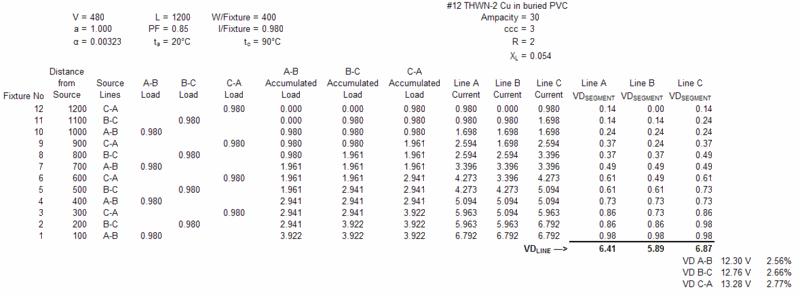Bob, In my earlier post i said that the wire sizes seemed a little high for being so close to the source.I used 3 different methods to figure vd and came up ith the same results.Method 1 was using the 2kli/vd=cm. Method 2 was using your theory,but plugging in different numbers, and method 3 was using the online calculator. The online calculator matched your theory but plugging in different numbers.See if this table looks right.
footage,amps,max vd,ohms,ohms/kft,awg,ohms/kft,multiplier,vd,calculator
1200,-- 1.66,- 7.2,-- 4.33,-- 1.8,--- 10,-- 1.2,----- 2.88,- 4.78,- 4.9.--
1100,-- 3.22,- 7.2,-- 2.16,-- .98,--- 8, -- .78,------1.71,--5.67,--5.7,--
1000,-- 4.98,- 7.2,-- 1.44,-- .72,--- 6,--- .49,------.98,---4.88,--4.9,--
900,--- 6.66,- 7.2,-- 1.08,-- .60,--- 6,--- .49,------.88,---5.86,--5.9,--
800,--- 8.33,- 7.2,--- .86,-- .54,--- 6,--- .49,------.78,---6.49,--6.5,--
700,--- 9.96,- 7.2,--- .75,-- .53,--- 6,--- .49,------.68,---6.83,--6.9,--
600,---11.62,- 7.2,---.61,-- .51,--- 6,--- .49,------.58,---6.83,--6.9,--
500,---13.33,- 7.2,---.54,-- .54,,---6,--- .49,------.49,---6.53,--6.6,--
400,---15.00,- 7.2,---.48,-- .60,---6,----.49,------.39,---5.85,--5.9,--
300,---16.66,- 7.2,---.43,-- .71,---6,----.49,------.29,---4.83,--4.9,--
200,---18.33,- 7.2,---.39,-- .97,---8,----.78,------.31,---5.68,--5.8,--
100,---20.00,- 7.2,---.36,-- 1.8,---10,---1.2,------.24,---4.8,---5.2,--
column1=footage of light bases
column2=amps at each base(coming back to the source)
column3=maximum voltage drop
column4=ohms(vd divided by amps)
column5=ohms/Kft(ohms divided by total footage(2-legs)x 1000)
column6=awg per table 9 pvc pipe
column7=ohms/Kft(per table 9)
column8=Multiplier(ohms/kft divided by 1000 x footage(2-legs)
column9=VD((multiplier x amps)
column10=Vd using online calculator using 75 degree c
Rick

